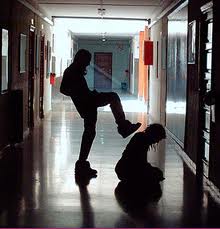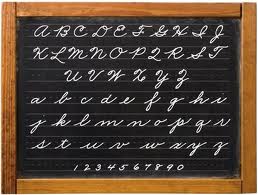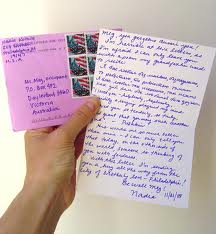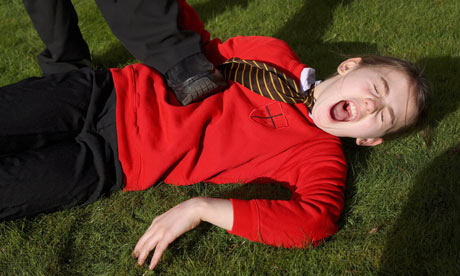Today is my birthday. I’m um… a year older than I was last year. 😉
Every year, for as long as I can remember, my parents have sent me a birthday card. Generally, my card arrives about two weeks early. This year’s card arrived on November 11th, so they are getting closer.
Inside the card, my mom always tells me that I am beautiful, that she remembers my birth as if it were yesterday, (I’ll bet she does), and she wishes me happiness, good health and good luck.
My father always writes me a poem. Well, technically, they are written an anonymous poet, whose handwriting just so happens to look exactly like my father’s script. Since nobody writes anymore, I have come to cherish these little ditties that my father (I mean, “anonymous”) pens for me.
This year’s poem reads:
There once was a girl named Schuls
Who didn’t care much for jewels
Her greatest wish
Was for people to be good in English
And follow the grammar rules.
And it’s true: I don’t care much for diamonds or pearls or rubies or emeralds or gold. And I do wish everyone would walk around with his or her grammar style-book at all times (just in case of an “affect/effect” emergency). But my greatest wish is that my parents stick around for a really long time – at least another hundred years – and that they keep sending me their fabulously goofy cards once a year. At least two weeks early. Their continued wackiness makes getting older a little easier.
Do you have a favorite birthday ritual?

Whenever I take on a project, where I am in a leadership role, where there are deadlines, where visible, public failure is possible – I get positively crazed. The desire for perfection makes me hustle to work, work, work – and in striving for perfection, the craziness kicks in.
This weekend I was grading essays. The. Entire. Weekend. You could not get me to stop. My husband came in at 2 pm and begged me to stop. My son came in at 3 pm and begged me to stop. They tried to stop me. They offered food. “I’ll eat when I am finished,” I said. I couldn’t be stopped. I was . . . driven.
Thankfully, I don’t have this problem with shopping (or sex) because it is powerful and unstoppable, and it would likely land me in the poorhouse or, in the case of the latter, in a starring role in an episode of Californication.
Hours later, after I’d completed all the grading, I felt miserable that I’d neglected my family all day. That isn’t right. I will try to be more mindful about this in the future. For once, I’d like to be in the club, rather than always being the “leader of the band.”
Related Articles
- Biting off More Than I Can Chew… (weddingbee.com)
Not long ago I received an email from my old friend. She sounded kinda panicky:
Renna:
I have been invited to go to a Bat Mitzvah in NYC for a co-worker’s daughter. What do I give? Help!
Jenna 🙂
That Jenna. She brought me right back to October 25, 1979 when I celebrated my own bat mitzvah in Syracuse, New York. Back then, my family attended an uber Orthodox synagogue where it was uncommon for girls to get the full bat mitzvah treatment. My neighbor (and most favorite babysitter) was the first girl at her Conservative temple to become a bat mitzvah, and I was only a few years her junior.
At our ultra-traditional temple, I wasn’t allowed to have a Saturday morning service for my bat-mitzvah; girls had to wait until sundown on Saturday to get things started. I wasn’t allowed to touch the Torah. Or use a pointer. Instead I read from the Book of Ruth, which had been laid on top of the Torah so as to appear that I was reading from the Torah. Mine was a pretty portion. I liked the symbolism of women taking care of other women, and I can still recite the words in Hebrew today.
Thanks to the Reform Movement, today, girls march right up on the bimah, just like their male counterparts. Girls chant their Torah portions beautifully (usually even more melodically than the boys), and congregants have come to celebrate the special days of both sexes with equal parts joy and pride. I was 100% ready for my bat mitzvah. I have always been a quick study when it comes to language, and Hebrew was no exception. Add a tune to the Hebrew, practice that tune a gazillion times, promise me a receptive audience, and hellooooo… let’s just say, I was ready to perform.
This is not the case for everyone. For some kids, preparing for “the big day” is really strenuous. For introverted kids, it can be a real challenge to get up in front of hundreds of people and not only speak but sing or chant in another language! And then there is a d’var torah where – for months – students prepare speeches for the congregation meant to explain not only what their specific Torah portion is literally about, but also what it means symbolically, philosophically, and how they connected to the portion personally. I always say if a child can get through his or her bar/bat mitzvah day, there isn’t anything he/she can’t do. It’s a crash course in language study, philosophy, essay writing, public speaking and etiquette lessons – all rolled into one.

For months leading up to my bat mitzvah, people kept asking me what I wanted. When I was 12, the only thing I wanted was a horse, so I just smiled a lot. And anyway, I knew what typical bat mitzvah gifts were. Besides engraved Cross pen sets and Webster’s Dictionaries, everyone I knew got the same thing: money, (to be saved for college) usually in the form of U.S. Savings Bonds. But it wasn’t polite to ask for money, and I would have sounded redonkulous if I had asked someone to buy me a horse.
So what’s the problem?
And why don’t I just answer Jenna?
I don’t know.
These days, I have an 11-year-old (with a bar mitzvah date already set for 20 months away), and suddenly this question is coming up near daily, and I have to be mindful. I don’t want to say the wrong thing or get myself in trouble.
Maybe it’s that bar and bat mitzvahs seem different to me now that I am an adult. These days there is so much more of everything. Everything has gotten super-sized. Even proms and graduation parties have become bigger-er. And b’nai mitzvah “after-parties” can get overblown and seem to have lost what the celebration is supposed to be about.
(Can you visualize me squirming around in my chair? Well, I am positively squirmy, Jenna. I’m sorry. I’m trying.)
Whenever anyone asks me about what is appropriate to give as a gift for a bar or bat mitzvah, I feel weird because there is no short answer. I can’t just say, “Buy him a pair of new pair of jeans,” or “Jewish girls love scented candles” because the bar or bat mitzvah is not like a birthday party celebration but a celebration of arrival through an entryway: an entryway to life as a responsible Jew. It is a spiritual rite of passage that connects one generation to another. Jewish children have studied for seven years, including that one intense year of tutoring to get them prepared for their few hours alone on the bimah.
I thought about Jenna’s email and all my non-Jewish friends who have asked me this same question for years, and I have decided to boldly go where no Jew has gone before: I’m going to suggest what you maybe-might-possibly consider giving (or not giving) to the b’nai mitzvah child.
(*Insert deep breath here.*)
When trying to determine what to give, you have to first ask yourself: How well do I know this person/family? That’s probably the single biggest factor that goes into the decision. You also have to consider how many people are going to attend to event: One adult? Two? The entire family? It matters.
I told Jenna about:
SIGNIFICANT NUMBERS. The #18 in Hebrew means “chai.” (No, not the tea. Stay with me, darlin’.) For those interested in pronunciation, to create the proper sound to recreate the word “chai” you have to know that the “ch” sound something like an elderly man trying to clear his throat of an enormous ball of phlegm. The “ai” rhymes with the word “hi.” If you can put that together, you’ve got it! For all the math teachers out there, each Hebrew letter has a numerical value. Cool right? Kinda like a secret code. The word for “life” in Hebrew is “chai.” The two Hebrew letters that make up the word “chai” are chet and yud. In Gematria (the numerical value of Hebrew letters), chai is equivalent to 8 and yud is equivalent to 10. So “chai” — chet + yud = 18. Giving money in multiples of $18 is symbolic of giving “chai” or life, so Jewish people often give denominations of chai. In our community, children often give $36. But people can get creative and give $100.18; big spenders may give $318 or $418 or $518 depending on whose special day it is and the nature of the relationship between the giver and the receiver. Family members generally give more than the average party-goer. Sometimes people add chai in increments: $18 + $18 = $36 (double chai), $54 = triple chai, $72= quadruple chai, and upwards from there.
(I know that’s a big range, Jenna.)
I explained that when it comes to monetary gifts, City Mice typically give waaaaay more than Country Mice, but I told her not to get hung up on that. While I know some people have said they find it helpful to think of a b’nai mitzvah like a mini-wedding, I don’t think one should think about a b’nai mitzvah like a wedding when it comes to providing a gift for the child. Wedding couples receive gifts because (in theory) they need items to furnish their new home together. Unless you have had a serious heart-to-heart with the parents of the child regarding a specific gift, in general, kids definitely don’t need more stuff.
Traditionally, Jewish people give money to the bar/bat mitzvah child. Why? Because cash is always the right color, the right size, and it goes with everything. (Ba da bump!) On a more serious note, historically the bar mitzvah was a way of helping to establish a young man with some money so that he might eventually be able to afford to make a home for his future wife. Yup, back in the old days, 13-years old boys were starting to think about marriage. These days, parents don’t marry off their sons or daughters quite so young. (We kind of like to keep them around, at least until they finish high school.) But once we move beyond that, the b’nai mitzvah became a way to save money for college. That’s just the way it was. All money went into the bank. Done deal.
Party-goers have told me they don’t like that all the money goes into the bank; they fret that the child gets “no real gift.” Trust me. Jewish children understand that their gift is the party. They get to invite and then enjoy being surrounded by the people who mean the most to them. They understand that the party is in their honor and that it represents all their years of hard work and study. They understand that they are considered adults (by Jewish Law), and as such they can consider how, and to what extent, they plan to carry out the 613 Mitzvot which cover everything that one might ever do during one’s life. And for a few hours, they get to enjoy being the center of attention.

SO WHAT ABOUT GIFT CARDS? People often ask if it is appropriate to give the bar/bat mitzvah child an iTunes card, a piece of jewelry, or a gift card to a favorite store. I’m going waaaay out on a limb on behalf of all Heebs out there and asking you (in the nicest of ways) to please refrain from giving b’nai mitzvah kids gifts or gift cards. Consider this: bar and bat mitzvah celebrations tend to be large, so…well… if even 20 kids give the bar mitzvah boy $25 gift cards to GameStop, that child would have $500 to GameStop. Would you want your son to have $500 in store credit to GameStop? Would you want your daughter to have twenty-five “Juicy Couture” handbags? Or twenty-five pairs of earrings? Probably not. So think of the returns? It is actually emotionally awful for b’nai mitzvah kids to have to decide which earrings or necklaces or handbags to keep and which have to be returned when they know their friends have worked hard to find them “just the right thing.”
I would never be so bold as to speak for everyone, but I believe the idea is to save the money for the child to use later, maybe not for an impending marriage, but for something significant, like a college education or perhaps a future trip to Israel.
I know bonds are no longer en vogue because interest rates have taken a dive (plus one has to have all kinds of information about the kid handy: social security number, address, age, weight, favorite color… well, it’s not quite that bad, but the folks at the bank definitely don’t make it easy to get bonds, that’s for sure), but back in the 1970s when that stack of savings bonds went into the safe deposit box, I didn’t feel upset. I completely understood that the money had been given to me to be saved for a time in my life when I would be able to use it for something important. And as my bonds came ripe, many years later, my husband and I were psyched to be able to use the money to help pay the down payment for our first home!
Okay, so I have pretty much worked poor Jenna up into froth. She just wants to know what to give. Enough already.
THE REAL ANSWER. The real answer is there is no right answer because there is no right or wrong when it comes to gift giving. Jewish parents don’t plan these celebrations hoping to “break even” or “make money.” We plan them to celebrate the years of hard work our children have put in to make it to their special day; because by the time our children make it to their b’nai mitzvah, they have clocked hundreds of after-school and weekend hours learning prayers, blessings, rituals, rites, symbols – even a whole other language while juggling academics, musical instruments, sports, and other extracurricular activities. It really is quite an accomplishment.
And the party isn’t supposed to be a “Phew, we’re done!” moment. The day is supposed to mark a beginning. The ceremony signifies the crossing from childhood into young adulthood and the emerging responsibility to fulfill the commandments and obligations identified with the Torah, the sacred laws and teachings written on parchment by hand in Hebrew.
Bottom line, when it comes to gift giving, you give from the heart. If you are invited to a b’nai mitzvah, know that the people who invited you really want you there. They really do. People should never give more than they are comfortable giving. Invited guests shouldn’t feel like they are competing with anyone with regard to what they give. But the best gift really is a check. I know, to some people, writing a check seems like a cold, impersonal gift, but if the day really is about transitioning into adulthood, well… it only makes sense that part of the event involves learning about deferring gratification and learning fiscal responsibility (even if the bar/bat mitzvah parents aren’t practicing for the moment).
I know. I know, Jenna. I haven’t answered you.
You still want to know how much.
I don’t know, sweetie. I mean, I have a number in mind but … I’m just not comfortable.
We’re a complicated people, Jenna.
Oy.
That’s my take. What do you think is an appropriate gift to give to a bar or bat mitzvah?
tweet me @rasjacobson
Recently I read one of the most amazing (and terrifying) blog entries called “Memories of a Bullied Kid,” on bullying from single dad laughing, a man who reflects back on a time in his life where he says he was systematically terrorized for years – but that he never said anything to anyone – except once. And he went further to report that when he reported the bullying, things got worse for him. Afterwards, he remained silent and endured the torture for over a decade. With so many students killing themselves these days, it amazes me that he is alive to tell the tale.
 In the all the bullying literature that is out there, there is one piece of the puzzle that hasn’t been particularly well documented, and so I’m putting out there. Guess what? Sometimes parents of bullies are proud that their children are bullies. I have heard parents admit they would rather have their children be the ones “standing up for themselves” than the ones being bullied: that they have actually encouraged their children to get physical first, so that they are never made targets themselves. For me, this is the ugliest, darkest side to parenting.
In the all the bullying literature that is out there, there is one piece of the puzzle that hasn’t been particularly well documented, and so I’m putting out there. Guess what? Sometimes parents of bullies are proud that their children are bullies. I have heard parents admit they would rather have their children be the ones “standing up for themselves” than the ones being bullied: that they have actually encouraged their children to get physical first, so that they are never made targets themselves. For me, this is the ugliest, darkest side to parenting.
Having been a teacher for 20 years now, and a parent for 11, I see that there is precious little time for elementary school to get to know each other at school. I know this because at the end of their 5th grade year, my son (and one friend) could not identify several of the children in their own class.
“I don’t know his name,” my son admitted.
His friend, who happened to be over that day shrugged: “Me either.”
It was unbelievable to me that my child and his friend could spend an entire year with the same people day in and day out and not know everyone’s first and last names, perhaps some tidbit of personal information.
I guess the sense of community has fallen out of the curriculum. Children are no longer taught to be good citizens, the ethics of being good people. The game is all about getting ahead, getting into the best schools — and kids learn early on that they may need to stomp on a few folks to get there. And I am sad to report that many parents encourage this type of aggressive, mean-spirited competition in athletics and academics. And meanwhile everyone is surprised that bullying in on this rise? Shocked when there is another incident reported, this time more gruesome than the last?
I never thought about college until 11th grade. Now, parents discuss college with their 1st graders. That’s a lot of pressure to put on children. When adults are stressed, they can go for a run, swim a few laps, take a yoga class. Well, kids get stressed out, too. But sometimes their stress comes out less constructively. So if you don’t even know all the kids in your class . . . well, why not pick on her? She’s weird. Or him? He’s quiet. Or, if you are really sneaky, get someone else to do it for you?
 Once learning their children have been acting as bullies, I’m always amazed at how unapologetic parents are. When I hear of kids who have been bullied and that some type of administrative action has taken place – even suspensions – where the school has agreed a particular child had overstepped too many times with too many kids – I am always shocked that part of the restitution never includes a written apology from the bully. No-one ever makes the offending kid write a note to the person he has been kicking around.
Once learning their children have been acting as bullies, I’m always amazed at how unapologetic parents are. When I hear of kids who have been bullied and that some type of administrative action has taken place – even suspensions – where the school has agreed a particular child had overstepped too many times with too many kids – I am always shocked that part of the restitution never includes a written apology from the bully. No-one ever makes the offending kid write a note to the person he has been kicking around.
If my child intentionally (or unintentionally) hurt someone, he’d either be over at that kid’s house apologizing in person or he’d be writing letters: to the kid he hurt, to the principal (indicating that he understood the infraction), to the parents of the bullied child explicating in essay form precisely what type of punishment(s) he would be receiving at home that would befit his behavior at school.
Apparently, most parents spend more time worrying about their child getting bullied than about their child being a bully. As a result, when they find out their child is bullying others, it takes them by surprise and they don’t know how to handle it.
What would you do if you found out your child was a bully? How would that conversation go? Would you be proud or horrified?

Not too long ago, my 6th grade Monkey had to sign several contracts – various agreements between himself and sundry teachers and coaches.
“Do I have to write in cursive?” 11 year old Monkey asks.
“It’s probably a good idea,” I reply.
There is a pause. Silence during which time I assume he is signing his name on the assorted colored sheets of papers. But after a while, I glance over and notice he has written only the first three letters of his first name. He is looking off into space, clearly stuck.
“Mom,” he says eventually.
“Mmmmm?” I ask, pretending to be oblivious but definitely aware of his dramatic pause. But I’m thinking to myself, maybe boy has some deep moral, ethical or philosophical opposition to being asked to sign a particular contract. I’m thinking maybe he is hung up on one of the terms. Maybe something seems unreasonable to him, and he is not willing to just sign on the dotted line. For a moment, I’m actually proud. I figure he’s read the contracts and internalized the content, and now he has questions, reservations. He’s thinking critically about his commitments and if he can take on more responsibility. . .
“I can’t remember how to make a “v” in cursive,” Boy announces. “I kinda forgot how.”

My child is in 6th grade. He is a stellar student. How could it be that he has forgotten how to make his “v’s” in cursive? I wonder. But I am patient. The school year is just kicking off, and he has been away for three weeks at overnight camp, playing in the dirt with friends, enjoying the heat of summer, so maybe he needs a quick mini-lesson.
“Sure, honey,” I say and prepare to give him a quick tutorial in cursive – which morphs into an elongated lesson because, as it turns out, Boy doesn’t remember how to make a capital “J” (which, for the record, is the first letter in his last name); neither does he recall how to make a lower case “b” (also a letter in his last name!).
At this point, I hear the ocean in my ears.
This is never a good thing as it generally means a giant wave is rising up from the deepest, angriest depths of me, and it generally culminates in a boatload of phone calls.
“Buddy.” I ask Mr. Calm, Cool and I’m-Not–Worried-At-All-That-I Don’t-Know-My-Alphabet-In-Cursive, “How is it that you do not know all your cursive letters?”
My son proceeds to explain to me that, while cursive letters were taught in 3rd grade, his teachers didn’t really require that he (or any of his classmates) write in cursive.
“Writing in cursive was pretty much optional,” Boy tells me.
Optional?
Optional!
(Can you hear the Atlantic, the Pacific, the Antarctic and Indian Oceans rolling around inside my head?)

I couldn’t help myself. I made a few calls to a few principals (who shall remain nameless) in a few local public schools (which shall remain nameless) in a few nearby districts (which shall also remain nameless). Most principals agreed that there is just so much material to cover to prepare students for standardized tests, that many things have had to go. (Damn you, No Child Left Behind!) One administrator told me that decisions had been made (note the passive voice) to focus less on cursive writing but that students could select cursive as “a font option” when printing from their computers.
Cursive? As a font option?
Really?
Hold on folks. I’m going back for a nostalgia moment.
I remember a time when we kids couldn’t wait to move from our world of block letters to the world of cursive which was infinitely more adult. (And I’m not the only one who felt this way! Read Kathy English’s awesome essay on the death of cursive!) My babysitters used cursive to write notes to each other, but I could never read their words as they were like some crazy, secret code I couldn’t decipher no matter how hard I tried. But I knew that one day I would eventually be deemed mature enough to learn “The Code,” that I would figure out how to connect letters by one single, continuous stroke. I knew I would learn to create words in loopy cursive letters and that, ultimately, I would be able to read my grandmother’s shaky script, my mother’s slanted hand, as well as my teacher’s perfect penmanship.

In the 18th and 19th centuries, cursive was one’s special signature. It distinguished one individual from another. The most elite received special training, and possessing a “fair hand” was considered a desirable trait for both men and women.
By the 1960s, a standardized method for teaching penmanship called D’Nealian Script had been introduced into schools all over the United States, and handwriting became more homogenized. I didn’t know any of this, of course, as I sat in class in 3rd grade in the mid-1970s. All I knew was that during “cursive time,” each of us learned to write the same way: on thin, oatmeal-colored paper that consisted of a series of two straight continuous horizontal lines with one broken line between them. We students sat with our pencils poised “at the basement” of the line ready to “go all the way up to the attic” or to stop “at the first floor.”
I remember being totally geeked up about learning cursive, but apparently, not everyone was as psyched about switching to cursive as this twit. And while I might have considered learning cursive a bit like taking a second art class, apparently, it wasn’t that way for everyone. For some kids, learning cursive was really difficult. I remember “the lefties” really struggled as did a bunch of kids who probably would have been diagnosed with some kind of fine-motor skill problem if they were going through the ranks today. But they didn’t test kids for things like that back in the 1970s. Instead, our teachers encouraged us (or goaded us, or punished us) until we learned our letters. And while we weren’t necessarily good at it right away, with daily practice, our shaky letters improved.
I wrote all my papers in cursive until my senior year in high school in the mid-1980s when my father brought home an enormous TRS-80 around the same time teachers were setting up the first “computer lab” at my high school.
So much has changed in twenty-five years! With the advent of word-processing and PDA’s and all things electronic, cursive has completely fallen out of favor. In fact, it has almost gone the way of the dinosaur. Without a doubt, typing is infinitely faster and easier to read than handwritten papers – but, now that I hear that cursive is not being reinforced, I wonder, is something being lost in making cursive optional?
 First, there is the obvious, esoteric stuff. When written properly, cursive is beautiful. Reading a handwritten note from a friend or lover is actually a completely different experience than reading the same content typed. Don’t believe me? Go back and look at some old photo album that belonged to somebody’s great grandmother. Look at the handwriting. You can actually feel something of the person in the handwriting. It is so much more intimate than reading something on a piece of paper that looks like it came from a school or the mortgage company. Have you ever received a thank-you note via email? Ewwwww. What about a thank-you via text? Double ewwwwww! There is nothing more lovely than holding a card in your hands on which someone took the time to write a nice note thanking you for something that you did for them. I swear, you can feel the gratitude in the loops.
First, there is the obvious, esoteric stuff. When written properly, cursive is beautiful. Reading a handwritten note from a friend or lover is actually a completely different experience than reading the same content typed. Don’t believe me? Go back and look at some old photo album that belonged to somebody’s great grandmother. Look at the handwriting. You can actually feel something of the person in the handwriting. It is so much more intimate than reading something on a piece of paper that looks like it came from a school or the mortgage company. Have you ever received a thank-you note via email? Ewwwww. What about a thank-you via text? Double ewwwwww! There is nothing more lovely than holding a card in your hands on which someone took the time to write a nice note thanking you for something that you did for them. I swear, you can feel the gratitude in the loops.
But “pretty” probably isn’t a good enough reason to keep cursive in the curriculum, right?
Ever the pragmatist, my husband says cursive will likely eventually disappear along with so many other “quaint niceties” like handwritten thank-you notes. He says the convenience of email and text will drive us away from handwriting altogether and computerized voice recognition and grammar programs will continue to improve. Hubby points out his signature is barely legible. It is his mark. “Well,” I countered, “At least you have a mark. Soon an entire generation of kids will be making X’s as they won’t be able to put their John Hancock on anything.” Hubby says I’m being overly dramatic, that I should calm down.

But I can’t calm down when I feel desperate inside. I’m the girl who still writes in journals and keeps yellow pads of paper filled with notes – all in cursive. My lesson plans are drawn up in cursive. My first draft of anything is always done in long-hand. I wonder what this means: if people cannot decipher their grandparents’ letters, how can they ever read important documents like our nation’s Constitution, Lincoln’s “Gettysburg Address” or our Declaration of Independence?
They’ll read those documents in textbooks,” Hubby responds. “Or online. More likely, they won’t read them at all.”
(I am pretty sure Hubby was just trying to pick a fight there.)
I shudder because as an educator I know things: the focus on cursive around third grade serves a larger purpose; it reflects the developmental connection between writing and thinking. Children who excel in handwriting skills tend also to excel in other academic pursuits. Cursive writing assists in the development of fine motor skills and muscle control, and it’s an introduction to self-expression. To abandon handwriting lessons could potentially interfere with the learning process as a whole.
I wish I could make some powerful claim that indicates students who are unable to read and write in cursive are guaranteed to score at least 100 points lower on their SATs than their cohorts who read and write in cursive. That would probably catch someone’s attention.
Doesn’t that look impressive?
Alas, I don’t have anything like that.
Sigh.
Americans are tired. We have been told that the sky is falling, the glaciers melting; the earth quaking; that strangers want to abduct our children, that neither government nor lawyers nor doctors can be trusted; the rainforests are being destroyed; that – in fact – the entire cosmos is running out of time. So who can bother to get upset over my li’l ole lament over the loss of cursive handwriting?
I think I’ll go write up a nice long grocery list – in cursive.
Just because I can.
Related Articles
- Handwriting skills waning, mother laments (cbc.ca)
- Mourning the Death of Handwriting (time.com)
- “Everybody Else Is Crazy” (andrewsullivan.theatlantic.com)

Scenario: You have been notified that your child has been arrested for doing something illegal. Your child has privately admitted to both you and your spouse that he did, in fact, do this thing.
Okay, it’s ethical question moment.
Would you make him accept the consequences, or would you hire the best lawyer you could afford and try to keep him out of trouble? Or is there some kind of middle ground?

See? I told you? I can’t help it! I recently wrote about my thing about Halloween and slutty Halloween costumes. I wasn’t even going to do anything this year. But it’s 2 PM, and the Annual Neighborhood Halloween Parade starts in a few hours. And I have to be something. But it’s cold out. Really cold. So, thinking practically, I started with my ski mask, added a pink wig, a tutu from ye olde costume bin, and one of Monkey’s old swords.
Poof.
I’m a Ninja Princess.
All I need is a tiara.
I’ve got an APB out for one right now, but it’s getting late!
Anyone have a tiara I can borrow?

When hubby and I lived in New Orleans, we kind of came to accept that conventional spelling and pronunciation were often disregarded.
When it came time for us to move north of the Mason-Dixon Line, we hired a few packers to help us with the job. They were nice gentlemen. Plump and toothless, Juno and Orly toiled tirelessly in the June heat to help us prepare for our move, and we appreciated their assistance.
When our moving van arrived in New York State, we were excited to unpack. Eventually came across one strangely enormous bundle labeled “mirows,” that had us stumped.
What the hell is a “mirows?” I wondered.
“I don’t remember buying a ‘meer-rows,'” hubby said as we unwrapped and unwrapped and unwrapped the mounds of bubble-wrap that Juno and Orly had painstakingly taped together in our old apartment several weeks prior.
Bubble-wrap followed by puffy, white foam and packaging tape followed by another layer of bubble-wrap, puffy foam and more tape. It was like peeling an onion. Juno and Orly had put a lot of care into wrapping up the mee-rows (?), but the tape had melted and fused with the plastic bubble-wrap, so we had to be careful because we really didn’t want to hurt our my-rose (?). We plowed away, but the bundle of mire-ohs (?) never seemed to get smaller.
“How many licks does it take to get to the center of a Tootsie Roll Pop?” Hubby joked, referring to a commercial from our youth in which a child questions a turtle and an owl about how long it would take to get to the Tootsie Roll Pop hidden inside the hard candy shell, if one could restrain oneself from biting.
“The world may never know,” I mimicked my best impression of the commercial’s deep voiced omniscient narrator.
Finally, we figured out what was in the package when we heard the pitiful sound of glass shattering: our two, formerly fabulous, incredibly ornate, big-ass mirrors were history.
I wish I had asked Juno and Orly about dem mirows.
Cuz they is gone.
I sho’ do miss N’awlins.
Where have you traveled where you’ve loved the dialect?

For real.
It’s happening.
I’m. Having. A. Total. Meltdown.
I’ve been trying to figure out this anti-plagiarism program called turnitin.com, and while the program appears easy enough to use, well, it isn’t working for me. And I seem to have found the ugly truth: apparently no one works at this company. There is no technical support. No phone number provided at which to reach a human.
After a major Internet investigation, I found a phone number. Elated, I dialed. And then I got that automated voice that tells you to please wait. Please wait. Please. Wait. (I watched an entire DVR’ed episode of Survivor while the music played in the background.)
Before I ever reached for the phone, I tried email. I explained my situation in detail, and somebody (a monkey?) sent me an email ticket indicating somebody (in India? in Texas? from Mars?) had received my angst-filled note(s) and promised I would be contacted within 24 hours.
I’ve been waiting for help since Monday.
I can’t get a human.
I can’t even get the sales rep.
So here’s a little video for your enjoyment.
You know, while I wait.
What makes your brain explode?

A while ago I chatted with Peter Lovenheim, author of the non-fictional narrative In the Neighborhood: The Search for Community On an American Street One Sleepover at a Time, He sipped coffee, and I ate a cupcake. We talked a bit about neighborhoods and neighbors. I even blogged about it.
Given my solid track record in easily making new friends wherever I have lived, it never occurred to me that I might make enemies. After our family moved into a new neighborhood, one neighbor came on particularly strong. She seemed fabulous. She brought me flowers for no reason at all, bought my son special books and funny little toys. She invited me over for tea at her house; I reciprocated with coffee and dessert.
Looking back at it now, I should have seen it coming. She was like that guy you date three times and then he professes his undying love for you. It feels a little premature, but you go with it because it feels good. Passionate. But then one day — out of the blue — he goes all ape-shit on you and breaks up.
In our case, after many months of relaxed interactions, we received one venomous phone call during which my neighbor accused me of doing something (which, for the record, I didn’t do). It’s all a misunderstanding, I assured my husband. We can totally work this out. That night I planned to clarify, to let her know there was no “situation,” that I had done nothing. I wanted to prove I was innocent. She wouldn’t even come to the door. Finally, her husband came to the driveway and assumed the international sign of a really pissed off person: arms crossed in front of his chest, legs set wide apart, a scowl on his face.
Proverbs 27:17 warns: “Visit your neighbor sparingly / Lest he have his surfeit of you and loathe you.”
I guess I should have paid better attention to Proverbs.
Suddenly, the easy-flowing conversations ended. No more chats about favorite hairstylists, discussions about favorite painters, plumbers or handymen. No more cheery hellos. For a while, I fretted daily at the injustice of it all. I couldn’t believe that Mr. and Mrs. Formerly Such Nice Neighbors could be so rigid and judgmental, even after I’d assured them I hadn’t done the thing they’d accused me of doing. I couldn’t believe they would bear false witness against their neighbor.
As time has passed, however, my husband and I have found that silence makes a lovely neighbor. Hubby refuses to let Mr. and Mrs. Formerly Such Nice Neighbors change the way he does anything. Hubby still mows the lawn on his big ole riding mower. He plants day lilies and futzes around with the landscaping, constantly relocating perfectly good elephant hostas from one place to another. Sometimes, he still even says hello. Call me petty, but I am not interested in forging any kind of anything with these people.
As I see it, they owe me an apology.
I did learn something from The Formerly Such Nice Neighbors. I learned that while I am likable — and I am — not everyone has to like me. And believe me, there are plenty of people out there who don’t like me, of this I am sure. That being said, the world keeps spinning and the grass keeps growing. I also learned not everyone wants to be neighborly. It’s okay.
As time has passed, I’ve had a chance to focus on my true friends: who they are and the qualities they possess that I appreciate. My closest friends are steadfast, kind, communicative, funny, creative, giving and forgiving. Each of them offers me something to learn – about myself and my place in the world.
With friends like those, who has time to worry about angry folks?
Got any good/funny/awful neighbor stories to share?




